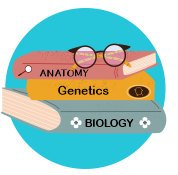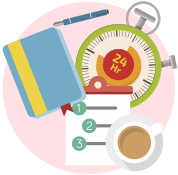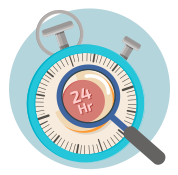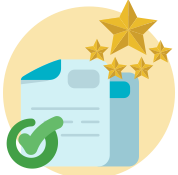Welcome to a chapter that's all about finding that sweet spot in the whirlwind life of a scientific illustrator. We're diving headfirst into the art of balancing, and trust me, it's no ordinary feat. From walking the tightrope between illustrating and studying to juggling our creative sparks with the pursuit of professional growth, we've got a lot on our plates. And let's not forget the ultimate challenge: harmonizing our professional journey with the personal lives we cherish.

Picture this: we are the modern-day alchemists of creativity and knowledge. Our canvas isn't just a canvas; it's a canvas of equations, cells, and constellations. We're here to weave the intricate threads of science into captivating visuals, and that requires us to be not only artists but scholars in our own right.
Striking that equilibrium between wielding the brush and delving into textbooks is an art in itself, and it's exactly what we're about to unravel.
But that's not where our balancing act ends. We're like acrobats of the mind, teetering between letting our creativity run wild and honing our skills through professional development. It's not enough to just master our craft; we need to grow with it. And while we're on this journey of growth, we can't ignore the drumbeat of marketing strategies. It's like being a symphony conductor for our own careers – orchestrating our artistic evolution while harmonizing it with the demands of the market.
Ah, and then comes the grand finale – the one that's often overlooked but holds the key to our overall well-being: balancing our professional ambitions with the lives we build outside of our creative realms. As much as we're passionate about our art, we're also parents, friends, adventurers, and dreamers. Navigating this intricate dance between career and personal life is a challenge we can't ignore.
So, my fellow scientific illustrators, in this chapter, we're peeling back the layers of the balancing act that is our life. We're diving into the strategies, and lessons learned from those who've walked this path before us. Whether you're trying to find more hours in the day for both art and study, seeking ways to channel your creativity while keeping up with industry trends, or just striving for that elusive harmony between work and play, we've got your back.
Get ready to explore the art of balance in all its forms – the interplay between illustration and study, creativity and professional growth, marketing and development, and the ultimate quest for equilibrium in the vibrant tapestry of our careers and personal lives.

It's a journey worth taking, and by the time you're done with this chapter, you'll be armed with insights and inspiration to master your own balancing act as a scientific illustrator.
The Importance of Time Management in Achieving Professional Growth
In the dynamic world of scientific illustration, where creativity and precision intertwine, mastering the art of time management is not just a skill – it's a key to unlocking professional growth and personal fulfillment.
As a scientific illustrator, your journey is a dual one, where your creative brilliance marries your insatiable hunger for knowledge. And in this delicate dance, effective time management emerges as your guiding light.
Picture this: every stroke of your brush and every moment dedicated to delving into the intricacies of science is a step forward in your quest for professional excellence. Here's why mastering time management is pivotal in your journey:

1. Maximizing Productivity:
Time management ensures that your creative efforts are channeled into productive work. When your valuable time is organized and optimized, you're better equipped to produce high-quality illustrations and engage in meaningful study sessions.
2. Balancing Creativity and Learning:
As a scientific illustrator, you're constantly balancing the demands of artistry and scholarship. Effective time management enables you to strike that balance, allocating sufficient time for both creative expression and deepening your understanding of scientific concepts.
3. Long-Term Vision:
Time management encourages you to step back and view your journey holistically. It allows you to set long-term goals and allocate time to work steadily towards achieving them, nurturing your career growth over time.
4. Navigating Professional Development:
Time management is the compass that guides you through the labyrinth of professional growth. It enables you to dedicate time to enhance your skills, explore new techniques, and adapt to changing industry trends.
5. Seizing Opportunities:
The world of illustration and science moves fast, and opportunities often come knocking when you least expect them. A well-organized schedule empowers you to quickly respond to these opportunities, whether it's a new project, collaboration, or learning opportunity.
6. Preventing Burnout:
Juggling creativity, learning, and the demands of your career can be exhilarating, but it also carries the risk of burnout. Effective time management ensures you allocate time for relaxation, self-care, and personal pursuits, safeguarding your mental and emotional well-being.
7. Building a Strong Reputation:
Delivering high-quality work consistently is a hallmark of professional growth. By managing your time effectively, you're better able to allocate sufficient attention to each project, resulting in exceptional outcomes that contribute to building a strong professional reputation.
8. Embracing Continuous Learning:
In the realm of scientific illustration, growth and learning are perpetual companions. Efficiently managing your time allows you to allocate dedicated periods for continuous learning, enabling you to stay updated with the latest scientific developments and incorporate newfound knowledge into your work.

Conclusion
In the realm of scientific illustration, where precision and creativity coalesce, time management is more than a tool – it's the bridge that connects your aspirations to your accomplishments. By mastering the art of managing your time, you're not just creating illustrations; you're shaping a successful and fulfilling career that is driven by your passion for both art and science. So, embrace the power of time management, and watch as it propels you towards unprecedented professional growth.
Ten Time Management Techniques
Here are ten time management techniques tailored to the needs of scientific illustrators aiming to balance their creative work and their quest for knowledge:

Time Blocking:
Divide your day into distinct blocks of time, each dedicated to specific tasks. Allocate time for illustration, study, professional development, and personal life. This structure prevents tasks from bleeding into each other and helps you stay focused on one aspect at a time.
Prioritization:
Determine the most critical tasks for the day or week. Focus on completing these high-priority tasks first to ensure that your core responsibilities are addressed effectively.
The Two-Minute Rule:
If a task takes less than two minutes to complete, do it immediately. This prevents small tasks from piling up and stealing time from your more substantial activities.
Eisenhower Matrix:
Categorize tasks into four quadrants: urgent and important, important but not urgent, urgent but not important, and neither urgent nor important. This matrix helps you prioritize tasks and allocate time accordingly.
Pomodoro Technique:
Work in focused intervals, typically 25 minutes, followed by a 5-minute break. After completing four intervals, take a longer break. This technique enhances concentration and prevents burnout.
Time Audit:
Regularly assess how you're spending your time. Identify time-wasting activities and areas where you can streamline tasks or delegate them to others.

Batching Similar Tasks:
Group similar tasks together and allocate specific time slots for them. For instance, dedicate one block of time to creating illustrations, another to studying, and yet another to responding to emails or engaging in marketing efforts.
Digital Detox:
Set aside specific periods during the day when you disconnect from digital distractions. This includes turning off notifications, stepping away from social media, and focusing solely on the task at hand.
Weekly Planning:
At the start of each week, outline your goals and tasks for the coming days. This helps you set a clear direction and maintain a proactive approach to managing your time.
Reflect and Adjust:
Regularly review your time management techniques and their effectiveness. If certain techniques aren't yielding the desired results, be open to adjusting or trying new strategies.

Conclusion
Implementing these time management techniques empowers you to effectively balance your artistic endeavors and your pursuit of knowledge. Customizing these techniques to align with your personal preferences and work style will help you make the most of your time, enhancing both your creative output and your learning journey.
Harnessing the Power of Planning Tools
In the intricate tapestry of scientific illustration, where precision meets creativity, the art of planning is the secret thread that weaves success. Enter the realm of planning tools – digital companions that streamline your tasks, amplify your productivity, and empower you to conquer the dual challenges of creativity and learning. In this chapter, we explore why using planning tools is essential for your journey and introduce you to five of the best ones to consider.
The Role of Planning Tools in Your Journey
Imagine having a personal assistant who effortlessly keeps track of your projects, deadlines, study sessions, and even your moments of relaxation. Planning tools are precisely that – they're your digital sidekicks that help you manage your time, tasks, and goals with finesse. These tools free up mental space, prevent overwhelm, and ensure that you're making the most of every moment.
Five of the Best Planning Tools

Trello:
This visual project management tool is like your virtual whiteboard. Trello uses boards, lists, and cards to help you organize tasks and projects. It's perfect for outlining your creative process, managing to-do lists, and even collaborating with team members.
Asana:
Asana is your command center for task management. It's designed to help you break down projects into actionable tasks, assign deadlines, and monitor progress. Whether it's tracking illustration milestones or study objectives, Asana has your back.


Notion:
Think of Notion as your digital Swiss Army knife. It's a versatile workspace that combines note-taking, task management, and knowledge organization. You can create customized databases, templates, and wikis to streamline your creative and learning endeavors.
Todoist:
If simplicity is your ally, Todoist is your go-to. This minimalist task manager lets you list tasks, set due dates, and categorize items by priority. It's perfect for those who want to focus on their to-do list without getting overwhelmed by bells and whistles.

Google Calendar:

Sometimes, the classic tools are classics for a reason. Google Calendar is a reliable scheduling tool that lets you organize your tasks, appointments, and deadlines in a visually intuitive format. You can also set reminders and share calendars with colleagues or collaborators.
The Synergy of Planning Tools and Time Management
The marriage of planning tools and time management is where the magic happens. Planning tools transform your intentions into actionable steps, allowing you to allocate dedicated time for illustration, study, professional development, and relaxation. They keep you accountable, prevent tasks from slipping through the cracks, and provide a clear roadmap for your daily, weekly, and monthly objectives.
Choosing the Right Tool for You
Each of these planning tools offers a unique approach to organization and productivity. The best tool for you depends on your personal preferences, work style, and the features that align with your needs. Take the time to explore these tools, experiment with their features, and find the one that seamlessly integrates into your workflow.
The Art of Delegating: Empowering Growth in Scientific Illustration
Amidst the demands of illustrating, studying, and professional development, there's an invaluable tool that can propel you forward while preserving your energy and focus: the art of delegating. Let’s delve into the significance of delegation and how it can be your key to unlocking new levels of achievement and fulfillment.
The Power of Delegating

Imagine having a team of skilled assistants working alongside you, each contributing their strengths to support your journey. Delegating is akin to having these assistants – it's entrusting tasks to others who are adept in those areas, allowing you to focus on what you do best. While your artistic flair and love for science are unparalleled, recognizing that you don't have to do it all by yourself is liberating.
Focusing on Your Zone of Genius
Delegating allows you to zone in on your strengths, the areas where you truly shine. As a scientific illustrator, your brilliance lies in your creativity, attention to detail, and understanding of complex concepts. By offloading tasks that fall outside your core expertise, you create space to amplify your artistic prowess and delve deeper into your studies.
Unlocking Time for Growth
Delegating isn't about shedding responsibility; it's about reallocating your time to foster growth. Imagine having extra hours to refine your artistic techniques, immerse yourself in scientific research, or engage in strategic professional development. Delegating gives you the gift of time, which is the most valuable resource on your journey.
Building a Collaborative Ecosystem
In the digital age, collaboration is a cornerstone of success. Delegating tasks doesn't just lighten your load; it creates opportunities for collaboration and synergy. Whether you're partnering with fellow illustrators, researchers, or professionals in related fields, the collaborative ecosystem you build can enhance your work and expand your horizons.
Effective Delegation in Practice
To effectively delegate, start by identifying tasks that others can perform without compromising quality. This might include administrative tasks, research, or certain aspects of project management. Next, consider your network – colleagues, freelancers, or specialized services that align with your needs. Communicate clearly, provide necessary guidelines, and maintain open lines of communication throughout the process.
Overcoming the Delegation Dilemma
It's natural to feel hesitant about delegating, especially when you're deeply invested in your work. However, overcoming this dilemma is pivotal for your growth. Recognize that delegating isn't a sign of weakness or relinquishing control; it's a strategic move that propels you forward.
Conclusion
By embracing delegation, you're embracing a pathway to enhanced productivity, personal well-being, and collaborative success. As you continue your journey, remember that delegating isn't just about offloading tasks; it's about entrusting others to support your growth and impact, ultimately shaping the trajectory of your artistic and intellectual endeavors.

Conquering Procrastination: Unleashing Your Potential in Scientific Illustration
In the captivating world of scientific illustration, where creativity and precision merge, there's an adversary that lurks in the shadows, threatening to derail your progress and hinder your growth: procrastination. This section is dedicated to unveil the importance of stopping procrastination in its tracks and reclaiming your time, creativity, and potential.

The Procrastination Predicament
Procrastination is a stealthy enemy that often disguises itself as harmless delay. It's the art of postponing tasks that require your attention, often for no reason other than momentary discomfort or distraction. In the realm of scientific illustration, where each stroke of your brush and every study session contributes to your excellence, procrastination is a formidable obstacle to be overcome.
Unlocking Your Creative Flow
Your creativity is a wellspring of inspiration waiting to be tapped. Procrastination stifles this flow, allowing doubts, fears, and distractions to take center stage. By conquering procrastination, you create an environment that nurtures your creative spirit, enabling you to produce your best work and harness your full artistic potential.
Maximizing Productivity
Every moment lost to procrastination is a moment that could have been dedicated to refining your techniques, exploring new subjects, or deepening your knowledge. Stopping procrastination allows you to allocate time more efficiently, ensuring that your valuable hours are spent on meaningful tasks that contribute to your growth as a scientific illustrator.
Embracing Discipline and Consistency
Procrastination thrives in the absence of discipline and consistency. When you actively combat procrastination, you cultivate a habit of disciplined work and consistency in your efforts. This habit, in turn, becomes a powerful ally in your pursuit of excellence and continuous improvement.
Overcoming the Fear Factor
Procrastination often masks a deeper fear – fear of failure, fear of the unknown, or fear of not meeting expectations. By addressing procrastination head-on, you're also addressing these underlying fears, allowing you to approach your work and learning with a newfound sense of courage and confidence.
Strategies to Defeat Procrastination
1. Break Tasks into Smaller Steps:
Large tasks can be overwhelming, leading to procrastination. Break them into smaller, manageable steps that are easier to tackle.
2. Set Clear Goals and Deadlines:
Define specific goals and deadlines for your tasks. Clear objectives provide a sense of direction and urgency that can counteract the pull of procrastination.
3. Use the Two-Minute Rule:
As I said it before, if a task takes less than two minutes, do it immediately. This prevents small tasks from accumulating and turning into procrastination triggers.
4. Eliminate Distractions:
Identify and minimize the distractions that often lead to procrastination. Turn off notifications, create a clutter-free workspace, and establish dedicated periods of focused work.

Embracing Progress over Perfection
One of the drivers of procrastination is the pursuit of perfection. Recognize that progress, even if it's imperfect, is far more valuable than waiting for the elusive "perfect moment." Embrace the concept of continuous improvement, and let go of the pressure to achieve flawlessness before taking action.
Conclusion
As you navigate your journey, remember that defeating procrastination isn't just about combating delay; it's about embracing the power of purposeful action, ultimately propelling you toward greater heights of artistic and intellectual achievement.
Embracing Focus: The Significance of Avoiding Multitasking
In the captivating world of scientific illustration, where precision meets creativity, the allure of multitasking can be a tempting siren song. However, in this chapter, we delve into the profound importance of avoiding multitasking and how it can be a catalyst for elevating your artistic excellence and scholarly pursuits.

The Multitasking Myth
Multitasking often wears the mask of efficiency – the belief that juggling multiple tasks simultaneously will save time and boost productivity. Yet, the truth is quite the opposite. Multitasking fragments your attention, dilutes your focus, and ultimately hampers your ability to produce high-quality work.
The Power of Singular Focus
As a scientific illustrator, your work demands a deep well of focus and concentration. Each stroke of your brush, each intricate detail you capture, and each moment of study requires your undivided attention. By avoiding multitasking, you're allowing yourself to immerse fully in the task at hand, resulting in work that is enriched with accuracy, creativity, and finesse.
Enhancing Cognitive Engagement
Scientific illustration is a marriage of artistry and knowledge. Deep cognitive engagement is essential to understanding complex scientific concepts and translating them into visual masterpieces. Multitasking disrupts this engagement, making it difficult to absorb information fully and distill it into your illustrations.
Quality Over Quantity
In the realm of scientific illustration, quality reigns supreme. The intricate details, nuances, and precision required demands dedicated focus. Avoiding multitasking ensures that each illustration and study session receives the attention it deserves, contributing to your growth and reputation as an accomplished scientific illustrator.
The Focus-Productivity Connection
Research has shown that multitasking not only diminishes the quality of your work but also reduces overall productivity. Shifting your attention between tasks incurs what's known as the "switching cost" – the time it takes your brain to refocus after switching tasks. This not only slows down your progress but also increases the likelihood of errors.
Strategies to Cultivate Focus
1. Prioritize Tasks: Identify your most important tasks and prioritize them. Focus on completing one task before moving on to the next.
2. Set Dedicated Time Blocks: Allocate specific time blocks for different tasks. During these blocks, commit fully to the task at hand without allowing distractions to infiltrate.
3. Eliminate Distractions: Create a distraction-free workspace. Turn off notifications, close unnecessary tabs, and communicate to others that you're in a focused work period.
4. Practice Mindfulness: Incorporate mindfulness techniques into your routine. Mindful work promotes sustained focus, helping you stay present and engaged in your tasks.
5. Use the Pomodoro Technique: Work in focused intervals, followed by short breaks. The Pomodoro Technique optimizes your concentration and minimizes the temptation to multitask.

Achieving Excellence through Singular Devotion
By immersing yourself fully in your work and studies, you're not just producing illustrations; you're crafting masterpieces that reflect your devotion, precision, and creativity. As you progress on your journey, remember that focus isn't just a choice; it's a mindset that propels you towards a level of artistry and knowledge that is truly exceptional.
The Vital Role of Rest and Relaxation in the Journey
It is easy to get caught up in the whirlwind of projects, studies, and continuous growth. However, there's a factor of this journey that often gets overlooked but is essential for your success and well-being – rest and relaxation. Let’s debunk the myth that resting is synonymous with idleness, and we're uncovering the profound importance of taking time to recharge.

Resting: A Noteworthy Investment
Imagine your mind and creativity as a garden that needs tending. Just as plants need water, sunlight, and nourishment, your mind and creativity require rest to flourish. Resting isn't a waste of time; it's an investment in your own vitality and creativity. Much like how a car needs fuel to run efficiently, your mind and body require downtime to function optimally.
Dispelling the Myth of Laziness
Let's address the elephant in the room – the misconception that taking time to rest is a sign of laziness. Nothing could be further from the truth. Resting is not about being inactive; it's about replenishing your mental and physical resources. Just as a scientific experiment needs time to develop results, your mind needs time to process information, insights, and ideas gathered during your creative and learning pursuits.
Revitalization Through Rest
Think of rest as the elixir that rejuvenates your creative spirit. When you step away from your canvas or your study materials, you're allowing your mind to reset. This reset isn't just about avoiding burnout; it's about unlocking a wellspring of inspiration and fresh perspectives. A relaxed mind is more receptive to creative insights and innovative solutions.
The Science of Rest
Research supports the invaluable role of rest in productivity and creativity. Studies have shown that adequate rest improves cognitive function, memory retention, and problem-solving abilities. By giving your brain the time it needs to rest, you're actually enhancing your ability to produce exceptional work when you're back in action.
Balancing the Equation
Resting isn't an indulgence; it's a necessity. In fact, effective time management includes allocating time for relaxation. Just as you allocate time for projects and learning, carve out time for activities that rejuvenate you. Whether it's reading a non-scientific book, taking a nature walk, or indulging in a hobby, these moments of leisure contribute to your overall well-being and creativity.
A Holistic Approach to Success
Ultimately, a well-rounded approach to success encompasses not just the hours dedicated to work and learning, but also the hours dedicated to rejuvenation. Resting isn't something to be guilty about; it's an integral part of the formula for long-term success. Your creativity, productivity, and overall quality of work will only benefit from giving yourself permission to rest and relax.

Recent Findings on the Benefits of Mindfulness in Fostering Creativity and Learning

In the fast-paced and often chaotic landscape of creativity and learning, the ancient practice of mindfulness has emerged as a transformative tool. Recent research has shed light on how mindfulness can enhance the process of creativity and learning, providing scientific validation to what many practitioners have long intuited.
Let’s explore the intriguing findings surrounding the benefits of mindfulness in cultivating creativity and facilitating effective learning.
Enhanced Focus and Attention
Studies have shown that mindfulness practices, such as meditation and deep breathing exercises, can significantly improve focus and attention. This heightened focus is particularly valuable in the creative process, where concentration on intricate details and innovative concepts is paramount. For scientific illustrators, this means that immersing yourself in mindfulness can enhance your ability to capture complex scientific ideas with precision and clarity.
Reduced Cognitive Overload
Creativity and learning can sometimes overwhelm the mind with a deluge of information, ideas, and tasks. Mindfulness has been found to reduce cognitive overload by helping individuals manage information more effectively. By practicing mindfulness, you can create mental space for creative insights and a deeper understanding of scientific subjects, leading to more informed and refined work.
Cultivation of Open Awareness
Mindfulness fosters a state of open awareness – an ability to observe thoughts, emotions, and experiences without judgment. This mental flexibility is essential for creative problem-solving and deepening your understanding of complex scientific concepts. By engaging in mindfulness, you can approach your work and studies with a curious and open mind, leading to more innovative solutions and profound insights.
Stress Reduction and Emotional Regulation
Stress is the arch-nemesis of creativity and effective learning. Recent studies indicate that mindfulness practices can significantly reduce stress levels and improve emotional regulation. This is crucial for scientific illustrators, as a calm and composed mind is better equipped to navigate the intricate demands of both artistry and scientific exploration.

Neuroplasticity and Cognitive Flexibility
Neuroscientific research reveals that mindfulness can promote neuroplasticity – the brain's ability to reorganize and adapt its neural connections. This enhanced neuroplasticity translates into improved cognitive flexibility, which is integral to both creativity and learning. Scientific illustrators who practice mindfulness may find themselves better equipped to adapt to new techniques, concepts, and artistic styles.
Synergy of Mindfulness and Creative Flow
Mindfulness shares a synergistic relationship with the state of creative flow – that elusive zone where time seems to stand still, and creativity flows effortlessly. Studies suggest that mindfulness can facilitate the onset of creative flow by reducing self-consciousness, anxiety, and distractions. This means that by cultivating mindfulness, you can tap into your creative reservoir with greater ease and consistency.
Integrating Mindfulness into Your Practice
To integrate mindfulness into your creative and learning endeavors, consider incorporating brief mindfulness exercises into your routine. A short meditation session before a study session or a deep breathing exercise before diving into a complex illustration can set the tone for focused, calm, and productive work.
Conclusion

By practicing mindfulness, you're not just embarking on a journey of self-awareness; you're equipping yourself with a toolkit to enhance your creative expression, deepen your understanding of scientific subjects, and foster a more harmonious and productive approach to your dual roles as a scientific illustrator.
As you explore the realm of mindfulness, remember that you're tapping into a wellspring of potential that can elevate your artistic and intellectual pursuits to remarkable heights.
Mindful Breathing Technique: The Anchor of Presence
One powerful technique of mindfulness is the mindful breathing practice, a foundational exercise that serves as an anchor to the present moment. This technique is simple yet profound, and it can be seamlessly integrated into your daily routine. Here's how to practice mindful breathing:
1. Find a Comfortable Space: Begin by finding a quiet and comfortable space where you won't be interrupted. You can sit in a chair or on the floor, whichever feels most comfortable for you.
2. Relaxed Posture: Sit with a straight but relaxed posture. Rest your hands on your lap or knees, whichever is comfortable. Close your eyes gently, or keep them open with a soft gaze – whichever you prefer.
3. Focus on Your Breath: Direct your attention to your breath. Feel the natural rhythm of your breath as you inhale and exhale. There's no need to alter your breath; simply observe it as it is.
4. Anchoring Your Awareness: As you breathe in and out, allow your breath to serve as an anchor for your awareness. When your mind starts to wander (as it inevitably will), gently guide your attention back to your breath without judgment.
5. Non-Judgmental Observation: As thoughts, emotions, or sensations arise, notice them without judgment. Acknowledge their presence and then gently return your focus to your breath.

6. Engage Your Senses: You can enhance this practice by engaging your senses. Pay attention to the sensations of your breath – the coolness as you inhale, the warmth as you exhale. Notice the rise and fall of your chest or abdomen.
7. Start Small: Initially, you might find it challenging to maintain focus for an extended period. Start with just a few minutes of mindful breathing and gradually increase the duration as you become more comfortable.
Incorporating mindful breathing into your routine offers a simple yet profound way to foster presence, enhance your creative output, and deepen your learning experiences. As you practice this technique, you'll discover that the moments of stillness and awareness you cultivate can ripple through your work as a scientific illustrator, enriching both your artistry and your intellectual pursuits.
